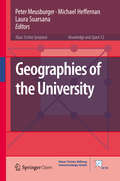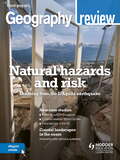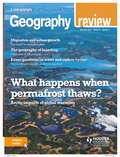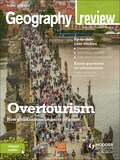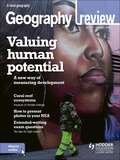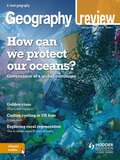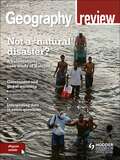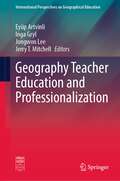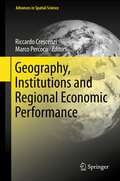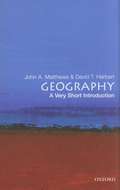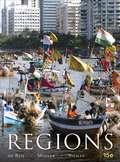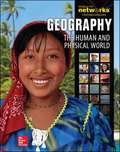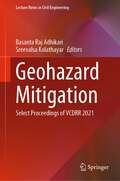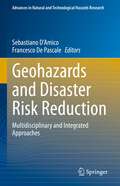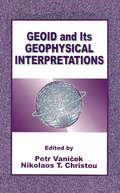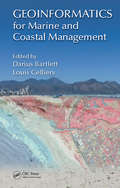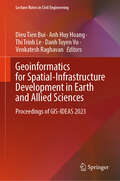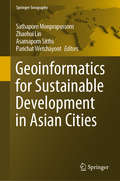- Table View
- List View
Geographies of the University (Knowledge and Space #12)
by Michael Heffernan Peter Meusburger Laura SuarsanaThis open access volume raises awareness of the histories, geographies, and practices of universities and analyzes their role as key actors in today’s global knowledge economy. Universities are centers of research, teaching, and expertise with significant economic, social, and cultural impacts at different geographical scales. Scholars from a variety of disciplines and countries offer original analyses and discussions along five main themes: historical perspectives on the university as a site of knowledge production, cultural encounter, and political interest; institutional perspectives on university governance and the creation of innovative environments; relationships between universities and the city; the impact of universities on national and regional economies and cultures; and the processes of internationalization through student mobility, the creation of education hubs, and global regionalism in higher education.
Geography
by Arthur Getis Judith M. GetisGeography introduces students to the scope and excitement of geography and its relevance to their daily lives. This edition continues to convey the breadth of geography and to provide insight into the nature and intellectual challenges of the field of geography itself.
Geography Review Magazine Volume 32, 2018/19 Issue 1
by Hodder Education MagazinesThis A-level geography magazine provides topical articles by experts in the field, specifically written for students to help them gain the highest grades. With up-to-date articles and case studies, it also includes advice on the NEA and approaching exam questions.ContentsHazard perception and risk: learning from the L'Aquila earthquake Noel Castree Question and answer Coastal landscapes and change Geographical ideas Representation David Redfern Achieving water security: a case study of Singapore Yvonne Follows-Smith Everybody's talking about... Premature deindustrialisation Simon Oakes Centrepiece Life expectancy in England: a north-south journey Clare Bambra and Chris Orton Storm Ophelia: a UK case study of extreme weather Sylvia Knight NEA ideas Researching inequality Martin Evans Global governance Getting to grips with global norms Simon Oakes Do food banks help? Food insecurity in the UK Jon May, Andrew Williams, Paul Cloke and Liev Cherry El Niño and La Niña: understanding extreme weather George Adamson Geographical skills How to use qualitative data: researching place with images and oral histories David Holmes The big picture The death of the Arctic? Jamie Woodward
Geography Review Magazine Volume 32, 2018/19 Issue 2
by Hodder Education MagazinesContents:Australia's migrants: impacts on urban growthIain MeyerQuestion and answerWater and carbon cyclesThe permafrost carbon feedback: the impact of global warming on Arctic ecosystemsPhilip WookeyThe equality of water supply in Lilongwe: a resource-security case studyNoel CastreeCentrepieceEarth's changing climateEd HawkinsAdapting to climate change: an agricultural case study from Nepal Mary Peart and Morgan PhillipsGlobal development update Modern slavery: an issue of global governanceGill MillerGeographical ideasInequalitySimon OakesThe geography of branding: using place to sell productsAndy PikeGeographical skillsHow to use qualitative data: researching place with interviews and social mediaDavid HolmesNEA ideasResearching place and brandingMartin EvansThe big pictureWhy are Africa's oldest baobabs dying?Jamie Woodward
Geography Review Magazine Volume 32, 2018/19 Issue 3
by Hodder Education MagazinesContents for this issue:Changing the meaning of place: a rebranding case study of Park Hill Flats, SheffieldQuestion and answerGlobal urbanisationEverybody's talking about...OvertourismRiver ecosystems: why do they matter?Geographical ideasCausalityCentrepieceWorlds of wealthMeasuring diversity of place: a case study of LondonThe global e-waste tradeCarbon updateGreenhouse gases: monitoring for mitigationWater security across borders: two international case studiesGeographical skillsUsing photos as evidence in your NEA: getting the picture rightNEA ideasChanging placesThe big pictureCan we tackle the ocean plastics problem?
Geography Review Magazine Volume 32, 2018/19 Issue 4
by Hodder Education MagazinesContents for this issue: Coral reef ecosystems: monitoring climate changeQuestion and answerExtended writing: ten tips for quality answersWhat happens to your rubbish? The geography of wasteFood security in Detroit: a case studyNEA ideas?Measuring surface roughness in natural systemsGeographical ideasInterdependenceCentrepieceCan London become a National Park?Geographical skillsUsing photos as evidence in your NEA: presenting and interpreting imagesWetlands in drylands: understanding dynamic environmentsGlobal development updateInternational trade: changing approachesMaking connectionsGlaciation, climate change and tectonic hazardsMeasuring development: can we improve on GDP?Index to Volume 21The big pictureDestroying the sense of place in Venice
Geography Review Magazine Volume 33, 2019/20 Issue 1
by Hodder Education MagazinesContents: Managing the world's oceans Clive Schofield and Noel Castree Question and answer Regeneration and deprivation Making connections Hazard and place David Redfern Golden visas: how elite migration works David Ley Everybody's talking about 5G Simon Oakes Global development update Changing gender equality Alice Evans Centrepiece Protecting the high seas Olive Hefferman Floodplain fens: a case study of carbon cycling Kate Heppell et al. Carbon update Global temperature targets: do they work? Noel Castree Platform capitalism and globalisation Daniel Whittall Glaciated limestone landscapes: landforms and processes Jamie Woodward and Philip Hughes Geographical skills Researching literature for your NEA David Holmes and Matt Smith NEA ideas Hazard and place Martin Evans The big picture Restoring peatlands as a carbon store Martin Evans
Geography Review Magazine Volume 33, 2019/20 Issue 2
by Hodder Education MagazinesContents:Human vulnerability to 'natural' disasters: a case study of Hurricane KatrinaChristine EriksenQuestion and answerWhy have I been given this? Ten tips to improve data interpretationHow can we manage global warming?Noel Castree and Rob BellamyMaking connectionsLandscapes, climate and diseaseDavid RedfernGeography worksFrom geography degree to NHS managementSir Andrew DillonCarbon updateCarbon in the river systemClaire GoulsbraCentrepieceThe Hong Kong-Zhuhai-Macau megabridgeOllie DaviesRestoring peatlands: can increasing a carbon store help us manage floods?Martin EvansGlobal trade patterns: how are they changing?Jessie PoonGlobal governance updateScales of governance: climate policy in the USASimon OakesAge segregation and place: social inequality in the UKAlbert SabaterGeographical skillsGetting your sampling rightDavid HolmesNEA ideasAge segregationMartin EvansThe big pictureAgriculture and water pollutionNoel Castree
Geography Teacher Education and Professionalization (International Perspectives on Geographical Education)
by Jerry T. Mitchell Inga Gryl Eyüp Artvinli Jongwon LeeThis book focuses on how current and prospective teachers worldwide are prepared for the significant task of teaching geography, given the important role of teachers. It eschews a traditional career-centric framework (pre-service, in-service teaching) in favor of a topical approach toward issues that all teachers face. The book updates thinking on geography education subfields such as GI education and fieldwork and traces important contemporary discourses such as digitalization and sustainability. The book further explains the broad variety of institutionalization of geography teacher education in various political systems. In short, this book collects strategies for geography teacher educators worldwide to provide insight into the challenges, conditions, and solutions present at the classroom and institutional level. As such, this book is a must-have for teacher educators and geography teachers worldwide.
Geography Tools and Concepts
by Heidi Hayes Jacobs Brenda Randolph Michal L LevasseurIncludes: A hands-on, active approach to practicing and applying key social studies skills, Engaging, step-by-step activities for exploring important topics in geography, High-interest selections by authors that help geographic concepts come to life.
Geography for Life: National Geography Standards, 1994
by Richard G. Boehm Sarah W. Bednarz Norman C. Bettis Roger M. DownsThe inclusion of geography as a core subject in Goals 2000: Educate America Act (Public Law 103-227) is the culmination of a decade of reform in geography education. There is now a widespread acceptance among the people of the United States that being literate in geography is essential if students are to leave school equipped to earn a decent living, enjoy the richness of life, and participate responsibly in local, national, and international affairs.
Geography in Britain after World War II: Nature, Climate, and the Etchings of Time
by Vinita Damodaran Max Martin Rohan D’SouzaContemporary anxieties about climate change have fueled a growing interest in how landscapes are formed and transformed across spans of time, from decades to millennia. While the discipline of geography has had much to say about how such environmental transformations occur, few studies have focused on the lives of geographers themselves, their ideologies, and how they understand their field. This edited collection illuminates the social and biographical contexts of geographers in postwar Britain who were influenced by and studied under the pioneering geomorphologist, A. T. Grove. These contributors uncover the relationships and networks that shaped their research on diverse terrains from Africa to the Mediterranean, highlighting their shared concerns which have profound implications not only for the study of geography and geomorphology, but also for questions of environmental history, ecological conservation, and human security.
Geography, Institutions and Regional Economic Performance
by Marco Percoco Riccardo CrescenziThe book aims to present "traditional features" of regional science (as geographical concepts and institutions), as well as relatively new topics such as innovation and agglomeration economies. In particular it demonstrates that, contrary to what has been argued by recent economics literature, both geography and institutions (or culture) are relevant for local development. In fact, these phenomena, along with the movement of goods and workers, are among the main reasons for persisting development differentials. These intriguing relationships are at the heart of the analysis presented in this book and form the conceptual basis for a promising institutional approach to economic geography.
Geography: A Very Short Introduction
by John A. Matthews David T. HerbertThis Very Short Introduction answers four basic questions: what is geography, how do geographers work, why is geography important, and where is the discipline of geography heading? Geography has always been important, though it has had only a short history as an academic discipline and is much misunderstood. Modern Geography has come a long way from its historical roots in exploring foreign lands, in mapping the world and in describing the physical and human features of the Earth's surface. There are two parts to the discipline: Physical Geography, which covers natural environments and landscapes; and Human Geography, which investigates people and the cultural landscape. Physical and human geographers commonly do not agree with each other. But there are also common elements and geography as a whole has an important role as a bridge between the sciences and the humanities. Using wide-ranging examples, the book paints a broad picture of the current state of geography, its subject matter, concepts and methods, how it developed, and its strengths and weaknesses. The book's conclusion is no less than a manifesto for geography's future.
Geography: Realms, Regions and Concepts
by Peter O. Muller H. J. de Blij NijmanThe 15th Edition of H. J. deBlij and Peter Mullers "Geography: Realms, Regions, and Concepts" has been expanded and enhanced upon previous editions. This carefully crafted text by one of the most traveled, knowledgeable and authoritative geography authors, H. J. deBlij provides a comprehensive understanding about the world with a long history of on authoritative content, outstanding cartography, currency, and comprehensive coverage, in a technology-rich package. A new online World Regional Geography program is one of many new strong and effective technologies included. New Organization Chapters are now divided into A/B sections. Within each chapter, Part A, Defining the Realm, examines developments that unfold across the entire realm or major parts of it. In Part B, Regions of the Realm, the authors explore the regions within the realms to view developments at a finer resolution and examine the role of individual states and national cultures. New and updated content incorporated into the narrative of every chapter. Chapters 8A and 8B (South Asia), for example, now discusses recent developments in the cultural and religious conflict between Pakistan and India, as well as a more detailed discussion of economic growth and effects of globalization in South Asia. New "Voice From the Region" feature, in every chapter. Each essay showcases the local perspective of an individual who resides in the realm. Many new photographs and field notes, taken by co-author Jan Nijman while doing fieldwork. New BBC videos, which can be used as lecture-launchers in class
Geography: The Human and Physical World
by Richard G. BoehmFocus on the big ideas with an accessible student text built around Essential Questions, enduring understandings, and national geography standards.
Geography: The Human and Physical World (Student Edition)
by MacMillan/McGraw-Hill StaffThis textbook elaborates on the importance of geography and the impact of geography on human life. Topics include: the human development index, distribution of political power, water scarcity, patterns of immigration, and more.
Geohazard Mitigation: Select Proceedings of VCDRR 2021 (Lecture Notes in Civil Engineering #192)
by Sreevalsa Kolathayar Basanta Raj AdhikariThis book presents the select proceedings of the Virtual Conference on Disaster Risk Reduction (VCDRR 2021). It emphasizes on the role of civil engineering for a disaster resilient society. It presents latest research in geohazards and their mitigation. Various topics covered in this book are land use, ground response, liquefaction, and disaster mitigation techniques. This book is a comprehensive volume on disaster risk reduction (DRR) and its management for a sustainable built environment. This book will be useful for the students, researchers, policy makers and professionals working in the area of civil engineering, especially disaster management.
Geohazards and Disaster Risk Reduction: Multidisciplinary and Integrated Approaches (Advances in Natural and Technological Hazards Research #51)
by Sebastiano D’Amico Francesco De PascaleThis book provides a comprehensive and multidisciplinary approach to addressing geohazards, with topics such as social vulnerability reduction, risk prevention, institutional preparedness, and community resilience. It also introduces new technologies to study geohazards, which is important since geohazards have caused many casualties, economic losses, and damage to cultural heritage throughout human history. Despite this, the culture of risk prevention is not yet widespread, so Disaster Risk Reduction activities must focus on increasing capacities, strategies, and action plans for prevention and preparedness in local communities.
Geoheritage of the Middle Atlas (Geoheritage, Geoparks and Geotourism)
by Khaoula BaadiThis book is a condensed summary of a broad spectrum of the geological heritage of the Middle Atlas. It has the particularity of proposing an in-depth synthesis and a critical review of the geoheritage of the region. The book addresses the issues related to geoheritage and methodologies for the selection, inventory, assessment and preservation of geosites. It reviews the state of the art of geoheritage in Morocco, particularly in the Middle Atlas, in order to identify geosites with rare and unique geological features. The book presents a detailed study of lithostratigraphic and sedimentological heritage as geosites witnessing at different spatial and temporal scales the evolution and the stratigraphic, sedimentological and paleogeographic history of the Middle Atlas range. It also presents the paleontological heritage of vertebrates by reviewing the discoveries of paleontological sites and their risks in order to present its conservation plans. It also addresses the hydric and fluvial heritage by presenting the potential of water resources and the impact of climate change on the latter. Furthermore, it highlights the karst heritage by exposing an inventory of exo- and endokarst geosites in order to emphasize some unique sites on a national and African scale as well as revealing the underground biodiversity related to this heritage. Finally, it proposes a presentation of the volcanic heritage in order to assess the volcanic geosites that testify to the strombolian, phreatomagmatic and Hawaiian dynamism of the region. The book is mainly intended for researchers, geologists and specialists of the Moroccan Middle Atlas region wishing to acquire a broad multidisciplinary or even transdisciplinary knowledge. It will also be accessible to a non-initiated public, interested in the richness of the Moroccan geoheritage, as well as to Moroccan territorial authorities (High Commission for Water and Forests, Ministry of Tourism, National Institute of Archaeology and Heritage Sciences, etc.) who can benefit from it in the perspective of their strategies of preservation of the national geological heritage. This work will be an example for geoscientists, on an African scale, of a valorization of territorial geological heritage.
Geoid and its Geophysical Interpretations
by Petr Vanicek Nikolaos T. ChristouGeoid and its Geophysical Interpretations explains how an accurate geoid can be constructed and used for a variety of applied and theoretical geophysical purposes. The book discusses existing techniques for geoid computation, recently developed mathematical and computational tools designed for applications, and various interpretations. Principles and results are well illustrated. This book will be an excellent reference for geodesists, geophysicists, geophysical prospectors, oceanographers, and researchers and students in geophysics and geodesy.
Geoinformatics for Marine and Coastal Management
by Darius Bartlett and Louis CelliersGeoinformatics for Marine and Coastal Management provides a timely and valuable assessment of the current state of the art geoinformatics tools and methods for the management of marine systems. This book focuses on the cutting-edge coverage of a wide spectrum of activities and topics such as GIS-based application of drainage basin analysis, contribution of ontology to marine management, geoinformatics in relation to fisheries management, hydrography, indigenous knowledge systems, and marine law enforcement. The authors present a comprehensive overview of the field of Geoinformatic Applications in Marine Management covering key issues and debates with specific case studies illustrating real-world applications of the GIS technology. This "box of tools" serves as a long-term resource for coastal zone managers, professionals, practitioners, and students alike on the management of oceans and the coastal fringe, promoting the approach of allowing sustainable and integrated use of oceans to maximize opportunities while keeping risks and hazards to a minimum.
Geoinformatics for Spatial-Infrastructure Development in Earth and Allied Sciences: Proceedings of GIS-IDEAS 2023 (Lecture Notes in Civil Engineering #411)
by Dieu Tien Bui Anh Huy Hoang Thi Trinh Le Danh Tuyen Vu Venkatesh RaghavanThis volume gathers the latest advances, innovations, and applications in the field of GIS and geo-spatial technologies, as presented by leading researchers and engineers at the International Conference on Geoinformatics for Spatial-Infrastructure Development in Earth & Allied Sciences (GIS-IDEA), held in Hanoi, Vietnam on November 7-9 2023. The contributions cover a diverse range of topics, including geoinformatics, geomatics, geospatial AI for natural hazards, Big Data and AI in sustainable natural resource management, GIS and remote sensing for natural disaster monitoring, GIS for spatial analysis, planning and management, GeoAI for building digital maps. Selected by means of a rigorous peer-review process, they will spur novel research directions and foster future multidisciplinary collaborations.
Geoinformatics for Sustainable Development in Asian Cities (Springer Geography)
by Sathaporn Monprapussorn Zhaohui Lin Asamaporn Sitthi Parichat WetchayontThis proceedings volume focuses on the importance and power of spatial thinking and planning, especially by applying geospatial technologies in solving the past and current global problems such as environmental degradation, urban pollution, climate change, agricultural management and epidemiology.The proceedings of the International Conference on Geography and Geoinformatics for Sustainable Development 2018 (ICGGS 2018) consist of a wide range of case studies from developing countries. The contributions address challenges of developing countries in mainstreaming sustainable development paradigm into their economy with the aim to improve and manage natural resources and environment in a sustainable manner. One of the main goals of the conference and the proceedings is to share and exchange different perspectives on global, regional and local spatial issues and how the concept of spatial planning and thinking can be used in building resilience to natural and anthropogenic threats in many sectors (such as water, ecosystem, agriculture and health). This includes a summary of how the key concepts of geospatial technologies could contribute to environmental sustainability and the Sustainable Development Goals (SDGs) as well as an outlook on challenges and opportunities for sustainable development. This book explains how geoinformatics can help analyse, model and explain sustainable development within a geographic context and thus provide the integrative framework necessary for global collaboration consensus and evidence-based decision-making. It highlights the vital and integrative role of geospatial information in driving sustainable development and thus can be used as a tool to put the 2030 Agenda for Sustainable Development into practice. This volume can be a useful resource for readers regarding research on geospatial issues on both the regional and local scale. Both undergraduate and graduate students around the globe can advance their academic and research knowledge of past and present environmental problems and learn how geospatial planning can be applied for sustainable development. It also appeals to researchers, academics, practitioners, community developers and policy makers interested in promoting sustainable development.
